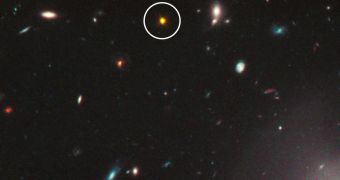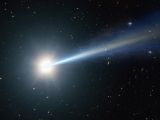Quasars are sometimes created by the supermassive black holes at the center of most if not all galaxies. They are the most luminous objects in the Universe, so far, and they're very important to the understanding of the early Universe in particular, since they can be seen from much farther away than most other objects.
Hundreds of thousands are known, most billions of years away. Still, there's a lot more we could find out about them, one quasar that has been puzzling astronomers enough for them to publish a paper on it.
The quasar in question, part of the J1148+5251 galaxy, is strange in that it's the only thing we can see there.
We know there's a galaxy full of stars surrounding it, the quasar needs to feed to stay luminous, but no light other than the quasar's is peeking through, NASA scientists have found.
The quasar is one of the oldest and the brightest, it formed less than one billion years after the Big Bang, in the wild years of the Universe.
Quasars are a lot brighter than the entire galaxy that feeds them, but even so, astronomers should be able to see the stars inside the galaxy after they remove the quasar's light.
That's not happening in this case. The explanation is that the galaxy is unusually dusty, so dusty that no light can escape it, at least no light we can see with Hubble, which was used to study the object.
Previous sub-millimeter observations of the galaxy had shown that it was unusually dusty, especially for one so young.
Hubble's Wide Field Camera confirmed the dust and found that it was very dense and, even more surprising, evenly distributed. Even dusty galaxies have some parts where light escapes. That's not the case here.
The supermassive black hole powering the quasar is giant, even by supermassive black hole standards, it weighs in at about three billion masses.
It had quite an appetite too, it gained most of this in just a few hundred million years. Activity has died down in the galaxy since then, the quasar only consumes the equivalent of several suns every year.
Astronomers have gone as deep as they could with Hubble and haven't been able to detect any light. However, they believe there is some light escaping and they believe the planned James Webb Space Telescope will be able to detect it since this quasar is going to be one of its targets.

 14 DAY TRIAL //
14 DAY TRIAL // 
